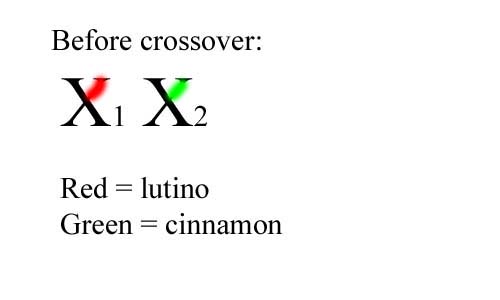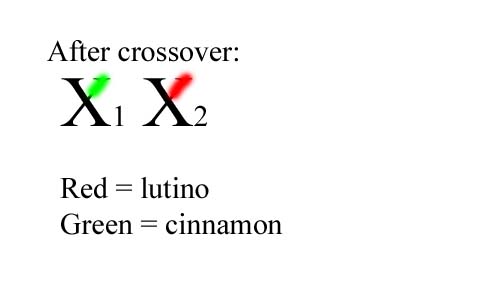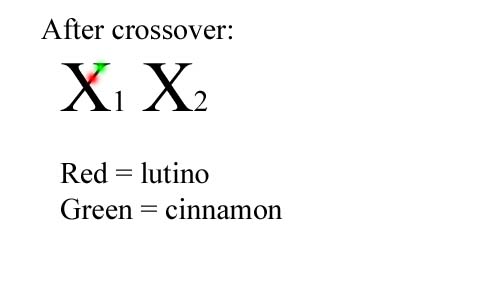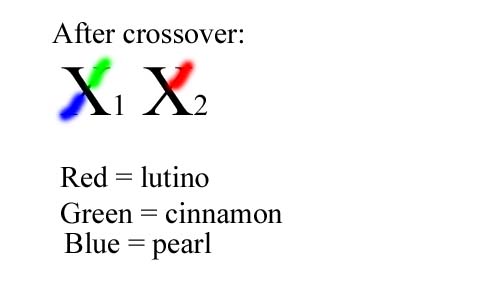Breeding & Genetics
Genetic Crossovers
Note: the sex chromosomes of birds actually function according to the ZW sex-determination system and this is the terminology used by scientific sources. It's customary in the pet-bird community to use XY terminology because it's easier to remember, and this article follows that custom.
What is a crossover? Well, chromosomes normally travel in pairs. When sperm and ova are formed these pairs break apart, so that each parent gives the chick one chromosome from each pair. But this is recombinant DNA so there will be some mixing and matching first. Before the chromosome pairs break apart, some of the genes are shuffled from one chromosome to the other, and each reshuffling may be different so there's a wide range of possible combinations. A segment of one chromosome in the pair will trade places with the matching segment on the other. Because this exchange happens in segments, genes that are close together tend to not get separated and genes that are farther apart are frequently separated.
Crossovers occur only within each chromosome pair, so that each gene will be matched up appropriately when a sperm fertilizes an ovum. There are no crossovers between one chromosome pair and a different chromosome pair, which would result in mismatched genes.
Crossovers and Color Mutations
The only crossovers that make any difference for color mutations are when the male has multiple sex-linked mutations. An individual has only one pair of sex chromosomes, and all of the sex-linked mutations are carried on the X chromosome(s) in this one pair. Males have two X chromosomes but females have one X chromosome paired with a Y chromosome. Crossovers can and do occur between the male's XX chromosomes. But the hen has only one X chromosome and its genes can not cross over to the Y, so all her sex-linked mutation genes have to stay exactly where they are. The genes for color mutations that are not sex-linked are on different chromosomes so crossovers can not occur between them.
Lutino and cinnamon are apparently close together on the X and crossovers between them are relatively rare (estimated rate=3%). Suppose we have a male with lutino on one X and cinnamon on the other. Suppose that both genes are carried on the top right arm of the X (This is a made-up location for illustration purposes; no one knows exactly where the genes are, and the chromosome isn't really shaped like an X). The colored segments show the location of each gene on the father's chromosomes:

Now suppose that there's a crossover between these entire segments. This is what you get:

Now the cinnamon gene is on X1 and lutino is on X2, but for practical purposes there is no difference. We still have one X with lutino on it and one with cinnamon on it.
Now let's get a little more precise about the location of those genes. Here's where they are on the father's chromosomes:

This time only a little segment from that part of the X trades places. Here are the results:

Now we have a difference! Instead of one X
with lutino and one with cinnamon, we have one X with lutino cinnamon and
one with no sex-linked mutations. Each of these X's is going to go into a
sperm, and if one of them fertilizes an ovum then the breeder will have some
unexpected results in the nestbox.
But the most common crossover involves opaline/pearl with lutino and/or
cinnamon, because opaline/pearl is further away from the other genes and
recombinations are more common (estimated rate = 30%). Now our father bird
has lutino pearl on one X and cinnamon on the other:

In our first example, nothing important happened when the whole upper-right segment of the X traded places. But look what we get when that same segment moves now:

Instead of lutino pearl on one X and cinnamon on the other, we now have cinnamon pearl on one X and lutino on the other. There are surprises in the nestbox once again.
Copyright 2014-2018 Carolyn Tielfan all rights reserved
